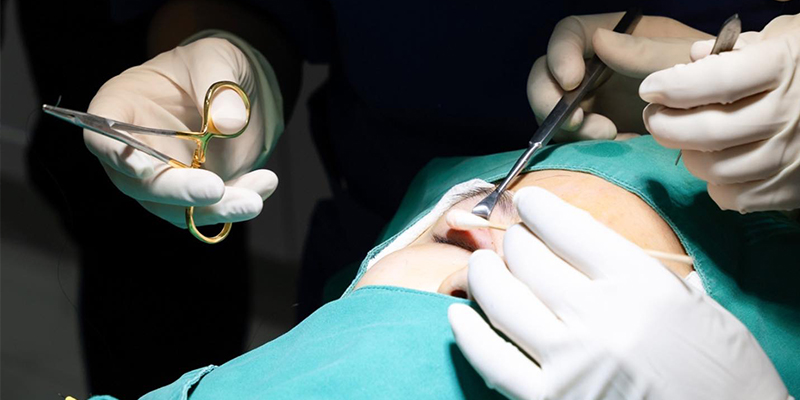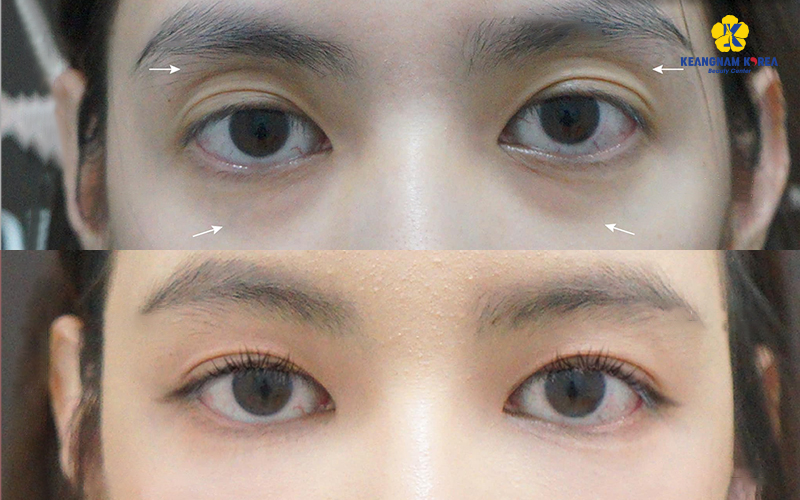Orbital fat grafting is a popular method for addressing issues like bulging eyes and deep-set eyelids, commonly offered at top beauty clinics. However, many clients are still concerned about its safety and how easy it is to care for afterward. Today’s article from Keangnam Korea will answer these questions and provide additional essential information to help you make an informed decision.

Nội dung
What is Orbital Fat Grafting?
The eyes are often referred to as the windows to the soul and play a crucial role in a person’s overall appearance. However, some individuals may experience deep hollows or bulging eyes due to a lack of surrounding fat. This condition is difficult to conceal with regular makeup.
Orbital fat grafting addresses these issues by providing a comprehensive solution, giving clients a refreshed and youthful look.
- Corrects bulging, tired-looking eyes
- Firms and smooths the skin
- Reduces under-eye bags, crow’s feet, and tear troughs
- Prevents sagging
- Acts as a “savior” for failed cosmetic procedures
As the name suggests, this technique involves harvesting fat from other areas of the body (such as the thighs, arms, or abdomen) and injecting it into the orbital area to fill in the hollowed regions. The advantage of using autologous fat (fat from the same body) is that it enhances compatibility and minimizes the risk of irritation or rejection. This leads to a smoother, safer cosmetic process.

Because the tissue is taken from the same body, even when it is separated and grafted, it can continue to grow and develop. This allows the eye area to recover more effectively and extends the results. Therefore, orbital fat grafting is a top choice for its effectiveness, adaptability, and long-lasting results in enhancing a youthful appearance.
Who Should and Shouldn’t Consider Orbital Fat Grafting
Orbital fat grafting is recommended for a wide range of clients across different ages and genders. It is commonly advised for individuals who experience:
- Signs of aging around the eyes in middle age.
- Sagging tear troughs and multiple wrinkles.
- Enlarged under-eye bags and dark circles.
- Lack of fat around the eyes, protruding eyes, or visible eyeball.
- Deep-set eyes due to genetic or congenital factors.
- Dull, tired-looking eyes.
- Previous eyelid surgery that didn’t achieve the desired results.
- Thin skin around the eyes with visible capillaries.
In addition to aesthetic reasons, some people seek consultations due to concerns related to physiognomy. Certain individuals might be perceived as picky, easily irritable, or authoritarian based on the appearance of their eyes. Therefore, they aim to improve their appearance to enhance both their beauty and their likability to others.

Contraindications to ensure safety include:
- Individuals under 18 years old.
- Those without signs of eye aging.
- Pregnant or breastfeeding women.
- Women during their menstrual period.
- Individuals with a history of cardiovascular disease, high or low blood pressure, anemia, or blood clotting disorders.
- Those with signs or a history of mental health conditions.
Is Orbital Fat Grafting Dangerous?
As mentioned earlier, orbital fat grafting minimizes the risk of rejection or complications due to the use of the patient’s own, pure fat. However, there are some important factors that affect whether the procedure is risky or not.
Reputable Facility – Skilled Surgeon
The eyes are a sensitive area with many nerves and thin skin. Therefore, it is crucial that the procedure is performed by a highly skilled and meticulous specialist to ensure a smooth and comfortable experience.

Currently, there are many unlicensed beauty clinics that forge credentials, so it’s crucial for clients to choose carefully. These places not only carry the risk of performing procedures incorrectly but can also pose serious health and even life-threatening dangers.
- Infection
- Unnatural eye appearance
- Inability to close eyes
- Vision impairment
Therefore, clients should seek out reputable, top-tier aesthetic clinics. They should be transparent about their certifications from the Ministry of Health and other relevant authorities. Documentation should include details about methods, expertise, staff, as well as equipment and technology. All these factors contribute to the safety of the procedures.
→ Learn more at: Where to get orbital fat grafting?
Quality of Fat Grafting
Even when using autologous fat grafting, the fat must be collected with specialized liquefaction equipment. It should then be carefully extracted and filtered through a centrifuge to retain the highest purity. This ensures that the filler material is highly compatible with the eye area, maintaining effective results.
Post-Operative Care
Many people focus on the risks during the procedure itself. However, post-operative care is equally important for achieving long-lasting, youthful eyes. Patients typically receive detailed guidance from their surgeon and follow-up results. Adhering to these instructions is crucial for a swift recovery.


Post-Orbital Fat Grafting Care
Each patient will receive personalized care instructions following orbital fat grafting. However, the general guidelines are quite simple and require minimal downtime.
- Avoid eye strain (e.g., applying makeup, rubbing your eyes) except for cleaning.
- Clean the eye area with saline solution.
- Protect your eyes from direct sunlight; always wear sunglasses and shield your eyes carefully when outdoors.
- Limit screen time on phones, computers, and other electronic devices.
- Stay indoors for 1-2 days after the procedure.
- Go to bed before 11 PM and ensure you get 7-8 hours of sleep each night.
- Stay well-hydrated.
- Increase your intake of vitamins through fruits, vegetables, nuts, and fish.
- Avoid stimulants like alcohol and tobacco.
- Limit foods that may cause scarring, such as beef, chicken, sticky rice, and seafood.
Maintain these habits for one month and follow up with your doctor as scheduled to monitor your results and address any concerns. After this period, you can comfortably use moisturizers and perform gentle massages around the area to help prevent wrinkles.
Cost of Orbital Fat Grafting
In addition to safety, the cost of orbital fat grafting is a major concern for clients. Currently, the average price for this procedure ranges from $500 to $1,200, depending on the service, the clinic performing the procedure, and the specific condition of the eyes.
For an accurate quote on orbital fat grafting, please contact our hotline 0911 833 555 to schedule a consultation with a professional doctor. The Keangnam Korea team is ready to welcome you and provide detailed guidance!








